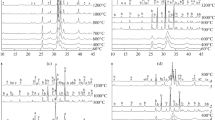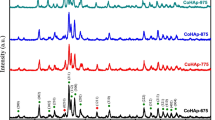Summary
Types of “H2O” in human enamel and in precipitated apatites are characterized using X-ray diffraction, infrared (IR) absorption spectroscopic and thermogravimetric analyses. Changes in lattice parameters (principally in the α-axis dimensions) and in the character of the IR absorption bands are correlated with weight losses at pyrolysis temperatures of 100° to 400°C and with effect of rehydration and reignition of previously ignited samples.
This study demonstrated that the loss of “H2O” below 200°C is reversible and causes no significant change in the lattice parameter of these apatites, whereas loss of “H2O” between 200° and 400°C is irreversible and causes a contraction in the α-axis dimension. It is proposed that two general types of “H2O” are present in these apatites: (a)adsorbed H 2O—characterized by reversibility, thermal instability below 200°C, and lack of effect on lattice parameters; and (b)lattice H 2O—characterized by irreversibility, thermal instability between 200 and 400°C, and induction of expansion in the α-axis dimensions of human enamel and precipitated apatites. Lattice H2O is assumed to be due to H2O-for-OH and/or HPO4-for-PO4 substitutions in these apatites. Loss of adsorbed H2O caused sharpening of the OH absorption bands in the spectra of these apatites. Loss of lattice H2O caused the appearance of P−O−P absorption bands (due to the presence of P2O7 4− group) in precipitated apatites containing small amounts of CO3 2−.
The observed larger α-axis of human enamel apatite, i.e., 9.445±0.003A, compared to that of the mineral or synthetic (prepared at 1000°C) OH-apatite, i.e., 9.442A, may be attributed to the presence of lattice H2O, Cl-for-OH, and concerted substitutions of larger cations (e.g., Sr, Ba, Pb, K) for Ca in this apatite.
Similar content being viewed by others
References
Carlstroem, D., Glas, J. E., Angmar, B.: Studies on the ultrastructure of dental enamel. V. The state of water in human enamel. J. Ultrastruc. Res.8:24–33, 1963
Casciani, F. S.: Identification of hydrate water in enamel, dentine, cementum and bone. In R. W. Fearnhead and M. V. M. Stack (eds.): Tooth Enamel II, pp. 14–23. John Wright, Bristol, 1971
Dibdin, G. H.: The stability of water in human dental enamel. Studies by proton nuclear magnetic resonance, Arch. Oral Biol.17:433–439, 1972
Myers, H. M.: Trapped water in dental enamel, Nature206:713–715, 1965
Myers, H. M.: Wide-line nuclear magnetic resonance (NMR) studies on enamel, Exp. Cell Res.38:686–691, 1965
Little, M. F., Casciani, F. S.: The nature of water in sound human enamel. A preliminary study. Arch. Oral Biol.11:565–571, 1966
Davidson, C. L., Arends, J.: Thermal analysis studies on sound and artificial decalcified tooth enamel, Min. Tissue Res. Commun. 2: 1976
Brauer, G. H., Termini, D. J., Burns, C. L.: Characterization of components of dental materials and components of tooth structure by differential thermal analysis. J. Dent. Res.49:100–110, 1970
Corcia, J. T., Moody, W. E.: Thermal analysis of human dental enamel, J. Dent. Res.53:571–579, 1974
Holager, J.: Thermogravimetric examination of enamel and dentine, J. Dent. Res.69:546–549, 1970
Sedlak, J. M., Beebe, R. A.: Temperature programmed dehydration of amorphous calcium phosphates, J. Coll. Interf. Sci.47:501–502, 1965
LeGeros, R. Z., LeGeros, J. P., Trautz, O. R., Klein, E.: Pyrolysis of biological apatites, Int. Assoc. Dent. Res. (IADR) Meeting, Abstract no. 171, 1970
Young, R. A.: Biological apatites vs. hydroxyapatite at the atomic level. Clin. Orthop.113:249–259, 1975
LeGeros, R. Z.: Crystallographic studies of the carbonate substitution in the apatite structure, Ph.D. thesis, New York University, New York, 1967
LeGeros, R. Z.: The unit-cell dimensions of human enamel apatite: effect of chloride incorporation, Arch. Oral Biol.20:63–71, 1971
Vignoles, C.: Contribution a l'etude de l'influence des ions alcalins sur la carbonatation dans les sites de type X des apatites phosphocalciques, Ph.D. thesis, Universite Paul Sabatier, 1973
LeGeros, R. Z., LeGeros, J. P., Shirra, W. P., Trauts, O. R.: Conversion of CaHPO4 to apatites; effect of carbonate on the crystallinity and the morphology of apatites. Adv. X-ray Anal.14:57–62, 1971
Zapanta-LeGeros, R.: Effect of carbonate on the lattice parameters of apatite, Nature206:403–405, 1965
Burnett, G. W., Zenewitz, J.: Studies on the composition of teeth. VII. The moisture content of calcified tooth tissues, J. Dent. Res.37:581–589, 1958
Angell, C. L., Shaeffer, P. C.: Infrared spectroscopic investigations of zeolites and adsorbed molecules, I. Structural OH groups, J. Phys. Chem.69:3463–3470, 1965
Hanser, E. A., LeBean, D. S., Perea, P.: The surface structure and composition of colloidal siliceous matter, j. Phys. Coll. Chem.55:68–79, 1951
Arends, J., Davidson, C. L.: HPO4 2− content in enamel and artificial carious lesions, Calcif. Tissue Res.18:65–79, 1975
Berry, E. E.: The structure and composition of some calcium-deficient apatites, J. Inorg. Nucl. Chem.29:317–327, 1967
Corbridge, D. E. C., Lowe, E. J.: Infrared spectra of inorganic phosphate compounds, J. Chem. Soc. 493–502, 1954
Herzberg, G.: Infrared and Raman Spectra of Polyatomic Molecules, Vol. 2. D. van Nostrand Co., New York, 1945
Joris, S. J., Amberg, C. H.: The nature of deficiency in nonstoichiometric hydroxyapatites. II. Spectroscopic studies of calcium and strontium hydroxyapatites, J. Phys. Chem.75:3172–3178, 1971
Gee, A. J., Davidson, C. L.: Mass spectrometry of enamel components released between R. T. and 450°C, J. Dent. Res.56:A49, 1977
LeGeros, R. Z.: Apatites from aqueous and non-aqueous systems: relation to biological apatites. Proc. First International Conference on Phosphorus Compounds, pp. 347–361. IMPHOS, Rabat, 1977
McConnell, D.: Deficiency of phosphate ions in apatite, Naturwissenschaften183:1–3, 1965
Simpson, D.: Carbonate in hydroxyapatite, Science147:501–502, 1965
Elliott, J. C., Mackie, P. E.: Monoclinic hydroxyapatite. In: Physicochimie et Cristallographie des Apatites de'interet Biologique, pp. 69–76. CNRS no. 230, Paris, 1975
Brown, W. E., Smith, J. P., Lehr, J. R., Frazier, A. W.: Crystallographic and chemical relations between octacalcium phosphate and hydroxyapatite, Nature196:1050–1055, 1962
Ingram, G.: The role of carbonate in dental mineral, Caries Res.7:217–221, 1973
Trautz, O. R.: Crystalline organization of dental mineral. In A. E. D. Miles (ed): Structural and Chemical Organization of Teeth, Vol. 2, pp. 165–200. Academic Press, New York, 1967
Heughbaert, J. C.: Contribution a l'evolution des orthophosphates de calcium non-cristalline en apatite, Thes d'Etat, Institut National Polytechnique de Toulouse, 1977
Bonel, G.: De la carbonation des apatites, Ann. Chim.7:124–144, 1972
Bonel, G., Montel, G.: Sur une nouvell apatite carbonatee synthetique, C.R. Acad. Sci. [D] (Paris)258:923–926, 1964
Author information
Authors and Affiliations
Rights and permissions
About this article
Cite this article
LeGeros, R.Z., Bonel, G. & Legros, R. Types of “H2O” in human enamel and in precipitated apatites. Calc. Tis Res. 26, 111–118 (1978). https://doi.org/10.1007/BF02013245
Received:
Revised:
Accepted:
Issue Date:
DOI: https://doi.org/10.1007/BF02013245




